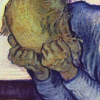Mood disorders involve a disturbance in an individual's mood, which could be characterized by either depressed mood or elevated mood to the point of mania. These disorders are fairly common, occurring in approximately 9.5% of the U.S. adult population over a 12 month period¹ and are often comorbid with other disorders such as anxiety disorders and substance abuse disorders.

Perhaps the most common of the mood disorders is unipolar depression, often referred to simply as depression or major depressive disorder. It is characterized by the experience of one or more major depressive episode, which can include depression, hopelessness, worthlessness, loss of interest in activities once enjoyed, and changes in behavior such as more or less sleep/eating. Depression is also associated with a high risk of suicide due to the individual's feelings, and because the disorder can be severely debilitating, it can be accompanied by loss of ability to function in terms of parenting, buying necessities, and going to work, which causes a major loss to the economy. Many different types of depression exist, including post-partum depression, dysthmia, psychotic major depression, and catatonic depression.
While depression is characterized by a purely depressed mood, bipolar disorder involves manic states as well as depressive states. An individual can switch between these two states over a few days, weeks, or even months. In a depressive episode, the individual may be able to do nothing but lay in bed and feel hopeless, much like unipolar depression. However, in a manic state, they will seem full of energy, may not sleep, act impulsively, and engage in risky behavior, such as doing drugs and quitting their job.
Bipolar disorder is characterized by three sub-types. Bipolar I disorder involves manic episodes with or without major depressive episodes, while Bipolar II disorder has hypomanic episodes (less severe states of mania) and depressive or mixed episodes. Lastly, cyclothymia includes hypomanic episodes and dysthymia (less severe states of depression).
Mood disorder treatment often includes cognitive-behavioral therapy and interpersonal therapy, and drug therapies can also be used, such as antidepressants for depression and antipsychotics, mood stabilizers, and lithium for bipolar disorder. Other treatments can also include building a good social support system for the client and encouraging exercise which can release endorphins. Often, a combination of all of these treatments is most effective.
Reference:
1. Kessler, R. C., Chiu, W. T., Demler, O., Walters, E. E. (2005). Prevalence, severity, and comorbidity of twlve-month DSM-IV disorders in the National Comorbidity Survey Replication (NCS-R). Archives of General Psychiatry, 62(6), 617-627.
© BrainMass Inc. brainmass.com April 22, 2024, 7:30 am ad1c9bdddf

